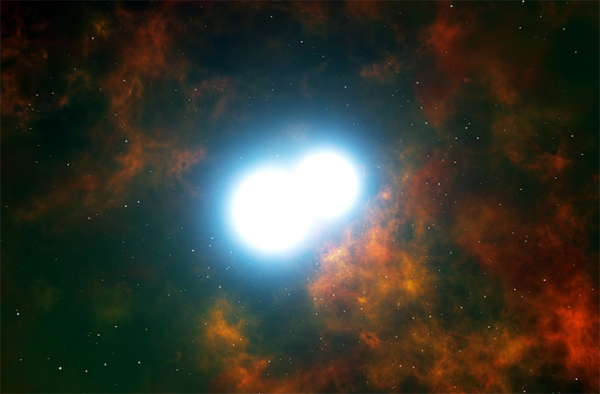Astronomers Discover White Dwarf Stars to Collide in Catastrophic Supernova
| Marco Foronda | | Feb 10, 2015 04:14 AM EST |
(Photo : ESO/L. CALÇADA) An artist's impression of the center of the Henize 2-428 planetary nebula, containing two white dwarf stars.
Astronomers used ESO's Very Large Telescope (VLT) to identify two surprisingly massive stars at the heart of the planetary nebula, Henize 2-428.
These two planetary bodies are both dwarf stars drawing ever nearer to each other. They will eventually collide and create one massive explosion. A thermonuclear explosion, that is to say, with a Type "la" supernova to follow. Dwarf stars have a total mass 1.8 times that of the Sun.
Like Us on Facebook
Astronomers that discovered the white dwarf face a different problem: discovering how some stars produce such strangely shaped and asymmetric nebulae late in their lives. The team is lead led by Miguel Santander-García from Observatorio Astronomico Nacional, Alcala de Henares, Spain and the Instituto de Ciencia de Materiales de Madrid (CSIC), Madrid, Spain.
They're using telescopes in the Canary Islands to view this heavenly conglomeration.
"Further observations made with telescopes in the Canary Islands allowed us to determine the orbit of the two stars and deduce both the masses of the two stars and their separation. This was when the biggest surprise was revealed," reports Romano Corradi, another of the study's authors and researcher at the Instituto de Astrofísica de Canarias (Tenerife, IAC).
Their findings support the theory that double central stars may explain the odd shapes of some of these nebulae. But an even more interesting result was to come.
The dwarf stars are sufficiently close to one another that they'll grow closer and closer and spiral-in due to the emission of gravitational waves before eventually merging into a single star within the next 700 million years.
"It's an extremely enigmatic system. It will have important repercussions for the study of supernovae Type Ia, which are widely used to measure astronomical distances and were key to the discovery that the expansion of the Universe is accelerating due to dark energy," concludes Santander-García.
The detailed study can be found in the current issue of Nature.
Tagsdwarf stars, Supernova, space exploration, double central stars, nebulae, nebula, supernovae Type Ia, Stars, ESO's Very Large Telescope
©2015 Chinatopix All rights reserved. Do not reproduce without permission
EDITOR'S PICKS
-

Did the Trump administration just announce plans for a trade war with ‘hostile’ China and Russia?
-

US Senate passes Taiwan travel bill slammed by China
-

As Yan Sihong’s family grieves, here are other Chinese students who went missing abroad. Some have never been found
-

Beijing blasts Western critics who ‘smear China’ with the term sharp power
-

China Envoy Seeks to Defuse Tensions With U.S. as a Trade War Brews
-

Singapore's Deputy PM Provides Bitcoin Vote of Confidence Amid China's Blanket Bans
-

China warns investors over risks in overseas virtual currency trading
-

Chinese government most trustworthy: survey
-

Kashima Antlers On Course For Back-To-Back Titles
MOST POPULAR
LATEST NEWS
Zhou Yongkang: China's Former Security Chief Sentenced to Life in Prison

China's former Chief of the Ministry of Public Security, Zhou Yongkang, has been given a life sentence after he was found guilty of abusing his office, bribery and deliberately ... Full Article
TRENDING STORY

China Pork Prices Expected to Stabilize As The Supplies Recover

Elephone P9000 Smartphone is now on Sale on Amazon India

There's a Big Chance Cliffhangers Won't Still Be Resolved When Grey's Anatomy Season 13 Returns

Supreme Court Ruled on Samsung vs Apple Dispute for Patent Infringement

Microsoft Surface Pro 5 Rumors and Release Date: What is the Latest?










